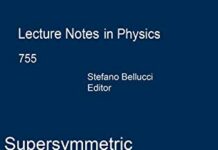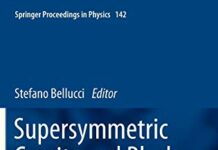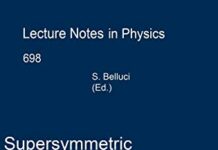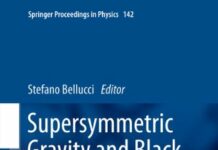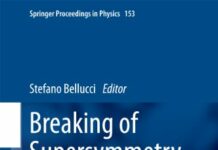
Ebook Info
- Published: 2006
- Number of pages: 251 pages
- Format: PDF
- File Size: 2.53 MB
- Authors: Stefano Bellucci
Description
This is the first volume in a series of books on the general theme of Supersymmetric Mechanics; the series is based on lectures and discussions held in 2005 and 2006 at the INFN-Laboratori Nazionali di Frascati. This volume supplies a pedagogical introduction, at the non-expert level, to the attractor mechanism in space-time singularities. After a qualitative overview, explicit examples realizing the attractor mechanism are treated at length.
User’s Reviews
Editorial Reviews: Review From the reviews:”This presents a comprehensive and detailed overview of the structure of supersymmetric black hole solutions in supergravity, critical point structure in the scalar field moduli space and the thermodynamic consequences. This second volume alone makes the set a worthwhile addition to the research library of any university active in fundamental theoretical physics.” (Kellogg S Stelle, Classical and Quantum Gravity, Issue 24, 2007)”The book under review is the second in a series devoted to supersymmetric mechanics. It concerns black hole solutions in supergravity theories. The book is divided into nine chapters. … This book provides very nice lectures on a powerful application of supersymmetry to the description of black hole entropy. … The text should be suggested as a reference book to students and researchers interested in the topic of attractor mechanism and related matters.” (Sergio L. Cacciatori, Mathematical Reviews, Issue 2008 c) From the Back Cover This is the second volume in a series of books on the general theme of Supersymmetric Mechanics; the series is based on lectures and discussions held in 2005 and 2006 at the INFN-Laboratori Nazionali di Frascati. The first volume appears as Lect. Notes Physics, Vol. 698 “Supersymmetric Mechanics , Vol .1: Supersymmetry, Noncommutativity and Matrix Models” (2006) ISBN: 3-540-33313-4.The present extensive lecture supplies a pedagogical introduction, at the non-expert level, to the attractor mechanism in space-time singularities. In such a framework, supersymmetry seems to be related to dynamical systems with fixed points, describing the equilibrium state and the stability features of the thermodynamics of black holes. After a qualitative overview, explicit examples realizing the attractor mechanism are treated at some length; they include relevant cases of asymptotically flat, maximal and non-maximal, extended supergravities in 4 and 5 dimensions. A number of recent advances along various directions of research on the attractor mechanism are also given.
Reviews from Amazon users which were colected at the time this book was published on the website:
⭐
⭐
⭐
⭐
⭐
⭐
Keywords
Free Download Supersymmetric Mechanics – Vol. 2: The Attractor Mechanism and Space Time Singularities (Lecture Notes in Physics, 701) 2006th Edition in PDF format
Supersymmetric Mechanics – Vol. 2: The Attractor Mechanism and Space Time Singularities (Lecture Notes in Physics, 701) 2006th Edition PDF Free Download
Download Supersymmetric Mechanics – Vol. 2: The Attractor Mechanism and Space Time Singularities (Lecture Notes in Physics, 701) 2006th Edition 2006 PDF Free
Supersymmetric Mechanics – Vol. 2: The Attractor Mechanism and Space Time Singularities (Lecture Notes in Physics, 701) 2006th Edition 2006 PDF Free Download
Download Supersymmetric Mechanics – Vol. 2: The Attractor Mechanism and Space Time Singularities (Lecture Notes in Physics, 701) 2006th Edition PDF
Free Download Ebook Supersymmetric Mechanics – Vol. 2: The Attractor Mechanism and Space Time Singularities (Lecture Notes in Physics, 701) 2006th Edition

